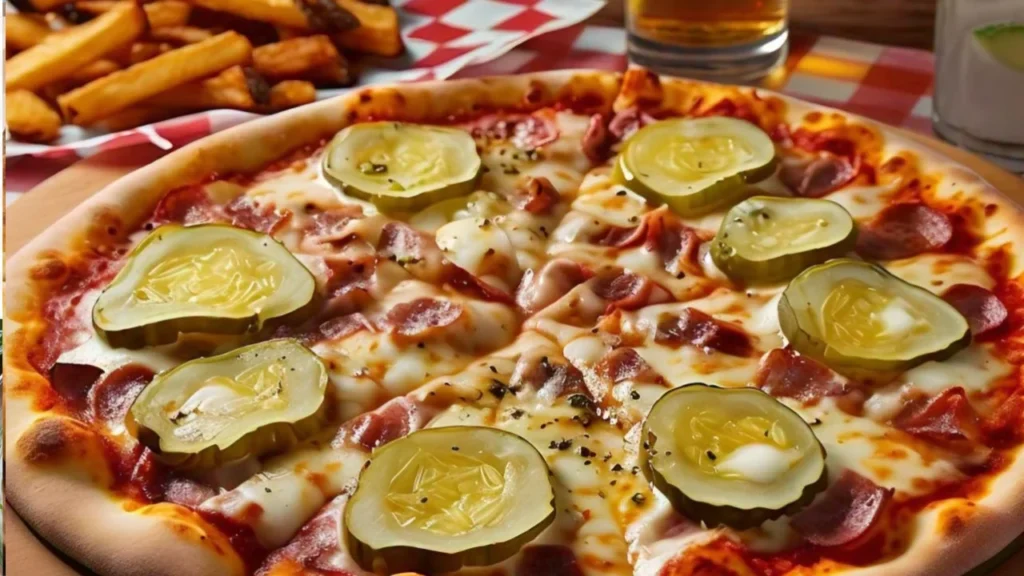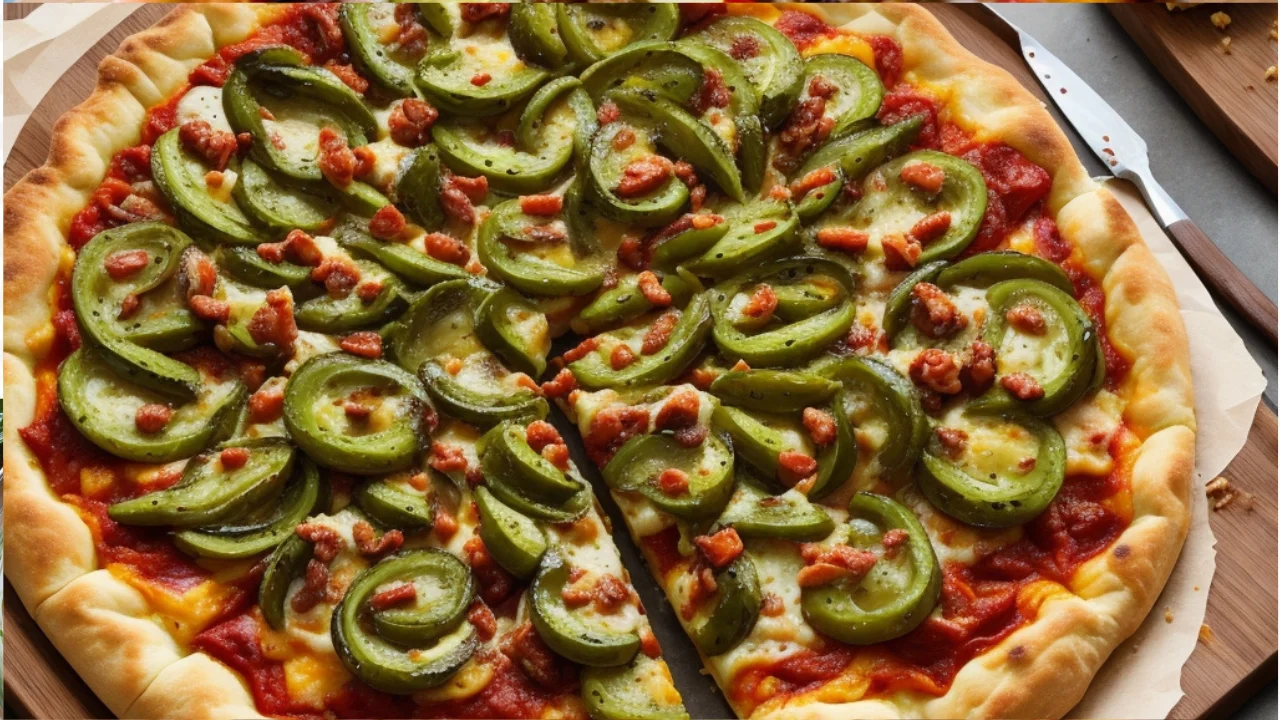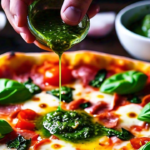The Pickle Pie Pizza Recipe may sound unconventional, but it blends the tangy flavor of pickles with the comforting elements of pizza, resulting in a dish that’s both surprising and delicious. Whether you’re a pickle lover or simply looking to experiment in the kitchen, this recipe is sure to intrigue and satisfy your taste buds. You can also explore other exciting veggie pizza options like Chimichurri Tomato Pizza, an Italian-inspired recipe that brings fresh, bold flavors to your table.
Why Pickles on Pizza?
At first glance, pickles on pizza might seem odd, but the combination makes perfect sense once you think about it. Pickles introduce a sharp, tangy flavor that cuts through the richness of the cheese, balancing the savory components of the pizza. This isn’t just about being different—it’s about enhancing the overall flavor profile in a way that traditional toppings might not.
Pickles, which started as a method of preserving cucumbers, have evolved into a versatile ingredient in many dishes. Their briny, tart flavor elevates various recipes, offering a contrast that brightens the dish’s overall taste. On a pizza, pickles add a unique complexity that complements the cheese and dough.
In regions where pickles are a staple, such as Eastern Europe, they are commonly used in various dishes. This cultural connection makes pickle pizza more than just a novelty; it’s a modern adaptation of traditional culinary practices. It demonstrates how familiar ingredients can be reimagined to create something both recognizable and new.
Tips for Success
- Pick Your Pickles Wisely: The pickles you choose will greatly affect the flavor of the pizza. Dill pickles provide a classic tangy taste, while bread-and-butter pickles add a hint of sweetness. Experiment with different pickle varieties to discover new and exciting flavor combinations.
- Balance the Flavors: Since pickles are salty and acidic, be mindful of how much you use. A balanced topping with the right amount of cheese and pickles will create a more enjoyable flavor profile. If unsure, start with fewer pickles and add more based on your taste preference.
- Experiment with Cheese: While mozzarella is the traditional choice, you can experiment with other cheeses like gouda or cheddar for a more complex flavor. Each cheese brings unique qualities—gouda adds smoky richness, while cheddar provides a sharp, tangy kick.
- Use a Pizza Stone: If available, a pizza stone is excellent for achieving a crispy crust. It retains heat better than a baking sheet, providing even cooking. For optimal results, heat up the stone in the oven before cooking.
Why This Recipe Works
The tangy pickles and creamy cheeses come together in a delightful harmony of flavors, with the acidity of the pickles perfectly balancing the richness of the cheese. The thin, crispy crust serves as the perfect base, ensuring that the pickles don’t overwhelm the pizza but instead complement it.
The uncomplicated nature of the ingredients enables the flavors to take center stage, unencumbered by excessive complexity. Meanwhile, the varied textures – crunchy crust, velvety cheese, and snappy pickles – come together to create a delightfully harmonious bite. This recipe is a testament to how unexpected combinations can result in the most delicious dishes.
Variations to Try

- Spicy Pickle Pizza: Add sliced jalapeños or a drizzle of hot sauce for a spicy kick. The spicy warmth of the jalapeños is expertly offset by the refreshing coolness of the pickles, resulting in a captivating flavor experience.
- Pickle and Bacon Pizza: Add crispy bacon pieces for a savory and smoky contrast to the tangy pickles. The bacon’s rich flavor pairs perfectly with the acidity of the pickles, making this variation a crowd-pleaser.
- Vegan Pickle Pizza: Use vegan cheese substitutes and a vegan-friendly pizza crust to make this recipe suitable for those on a plant-based diet. With the availability of high-quality vegan cheeses, it’s easy to create a version of this pizza that’s just as delicious and satisfying as the original. The creamy texture of vegan cheese paired with the tangy pickles provides a delightful contrast that even non-vegans will enjoy. Plus, you can customize it further by adding your favorite plant-based toppings for a personalized, guilt-free treat.

Ingredients
Notes
- Flour: All-purpose flour works well for this recipe, but for a chewier crust, consider using bread flour. Its higher protein content provides more elasticity, resulting in a chewier texture.
- Yeast: Active dry yeast is ideal for homemade pizza dough. Ensure your yeast is fresh; expired yeast won’t allow your dough to rise properly.
- Pickles: The type of pickles you choose will significantly influence the flavor. Dill pickles provide a strong, sharp taste, while bread-and-butter pickles offer a sweeter, more complex flavor.
- Cheese: Mozzarella is a must for its melting qualities, but don’t hesitate to add other cheeses like gouda or sharp cheddar for added depth. Ricotta adds creaminess, while Parmesan gives a salty, nutty finish.
Step-by-Step Instructions
Step 1: Preparing the Dough
The dough is the backbone of a perfect pie. For this recipe, we’re aiming for a classic thin crust that allows the pickles to shine.
- Activate the yeast: In a small bowl, mix the sugar and warm water, then sprinkle the yeast on top. Allow it to rest for 5 minutes, or until it develops a foamy texture. This step ensures that your yeast is active, which is crucial for the dough to rise properly.
- Combine the dry ingredients: Whisk flour and salt together in a large bowl until smooth. Salt is essential for flavor and helps control the yeast activity while strengthening the dough’s gluten.
- Combine: Add the yeast mixture and olive oil to the flour mixture. Stir until a dough forms. It may look sticky initially, but it will become smoother as you knead it.
- Knead: Transfer the dough to a floured surface and knead for 5-7 minutes until it becomes smooth and elastic. Kneading develops the gluten, giving the dough the right balance of chewiness and crispness.
- Let it rise: Put the dough in a greased bowl, cover it with a towel, and let it rise in a warm spot for about an hour, or until it has doubled in size. A properly risen dough will be light and airy, making it simple to roll out and shape.
Step 2: Preparing the Toppings
While the dough is rising, prepare your toppings. Balance is key—too many pickles can overpower the pizza, so be mindful of the proportions.
- Slice the pickles: If your pickles aren’t pre-sliced, thinly slice them using a mandoline for uniformity. Uniform slicing guarantees consistent cooking and a harmonious flavor profile.
- Mix the cheese: In a bowl, combine the ricotta, Parmesan, and half of the mozzarella cheese. Mix in the oregano, red pepper flakes, and garlic powder until thoroughly combined. This mixture not only adds flavor but also helps the pickles stick to the pizza, preventing them from sliding off.
Step 3: Assembling the Pizza
After your dough has risen and toppings are set, start assembling the pizza.
- Preheat the oven: Set your oven to 475°F (245°C) and place a pizza stone or baking sheet inside to heat up For a golden-brown crust, preheat a stone or sheet before adding the pizza.
- Shape the dough: Roll out the dough into a 12-inch circle on a floured board. Transfer it to a sheet of parchment paper for easier handling and to prevent losing toppings when transferring the pizza to and from the oven.
- Add the cheese mixture: Evenly distribute the ricotta cheese mixture over the pizza dough, leaving a small gap around the edges.
- Layer the pickles: Arrange the pickle slices over the cheese mixture, covering the pizza evenly without overlapping too much to avoid soggy spots.
- Add mozzarella: Sprinkle the remaining mozzarella cheese on top, helping to melt everything together for a balanced bite.
- Drizzle with olive oil: Lightly drizzle olive oil over the pizza to aid in melting the cheese and crisping the crust.
Step 4: Baking the Pizza
This is the moment when all the flavors unite.
- Bake: Carefully slide the pizza, using the parchment paper, onto the hot stone or baking sheet. Bake it (10-12 minutes), until the cheese is melted and the crust is golden brown, signaling it’s done.
- Garnish: Remove the pizza from the oven and let it cool slightly. Garnish with fresh dill or parsley to add a burst of flavor and color.
Serving Suggestions
Pickle Pie Pizza is best enjoyed fresh out of the oven, with the crust crisp and the cheese gooey. Enjoy it with a side salad or as an appetizer at your next event. If you’re feeling adventurous, drizzle some honey over the top before serving—the sweetness contrasts beautifully with the tangy pickles.
If you’re a fan of pairing meals with beverages, try a crisp white wine or light beer to complement the pickles’ tangy flavor. The acidity in these drinks enhances the pizza’s flavors without overpowering them. Alternatively, a cold glass of lemonade or iced tea provides a refreshing contrast to the rich, savory toppings.
FAQs
Q1. What is Pickle Pie Pizza?
A. Pickle Pie Pizza is an innovative pizza recipe that combines the tangy flavor of pickles with traditional pizza elements like cheese and a crispy crust. This unique combination offers a surprising and delicious twist on the classic pizza.
Q2. What type of pickles should I use for Pickle Pie Pizza?
A. Dill pickles are the most common choice due to their sharp, tangy flavor. However, you can also use bread-and-butter pickles if you prefer a slightly sweeter taste. Feel free to experiment with different pickle varieties to find your favorite combination.
Q3. Can I use store-bought pizza dough for this recipe?
A. Yes, you can use store-bought pizza dough if you’re short on time or prefer not to make your dough from scratch. Just make sure to follow the instructions on the package for best results.
Q4. What other cheeses can I use besides mozzarella?
A. While mozzarella is the traditional choice for its melting qualities, you can also use cheeses like gouda, sharp cheddar, or even feta. Each cheese will add its own unique flavor, so feel free to experiment.
Q5. How do I prevent the pickles from making the pizza soggy?
A. To avoid sogginess, slice the pickles thinly and avoid overlapping them too much on the pizza. The thin crust also helps by allowing excess moisture to evaporate during baking. Additionally, adding the cheese mixture before the pickles can create a barrier that prevents the crust from becoming soggy.
Q6. Can I make this pizza vegan?
A. Yes, you can make a vegan version of Pickle Pie Pizza by using vegan cheese substitutes and a vegan-friendly pizza crust. With the growing availability of high-quality vegan cheeses, it’s easy to create a plant-based version that’s just as tasty.
Q7. What are some good variations of Pickle Pie Pizza?
- Spicy Pickle Pizza: Add sliced jalapeños or hot sauce for a spicy twist.
- Pickle and Bacon Pizza: Incorporate crispy bacon for a savory and smoky contrast.
- Pickle and Ham Pizza: Add thinly sliced ham for a sweet and savory combination.
Q8. How should I store leftover Pickle Pie Pizza?
A. Refrigerate leftover pizza in an airtight container for a maximum of three days. To reheat, use an oven or toaster oven to maintain the crispy texture of the crust.
Q9. Can I freeze Pickle Pie Pizza?
A. Yes, you can freeze Pickle Pie Pizza. After baking, allow the pizza to cool completely, then wrap it tightly in plastic wrap followed by aluminum foil. Stock in the freezer (to 2 months). When ready to eat, thaw in the refrigerator and reheat in the oven.
Q10. What drinks pair well with Pickle Pie Pizza?
A. Pickle Pie Pizza pairs well with crisp white wines, light beers, or refreshing non-alcoholic options like lemonade or iced tea. The acidity in these drinks complements the tanginess of the pickles without overpowering the flavors of the pizza.
Q11. Can I add other toppings to Pickle Pie Pizza?
A. Absolutely! While the recipe focuses on pickles and cheese, you can add other toppings like onions, mushrooms, or olives to enhance the flavor. Just be careful not to overload the pizza, as it could affect the cooking time and texture.
Q12. Why should I try Pickle Pie Pizza?
A. Pickle Pie Pizza is a fun and creative way to enjoy pizza with a twist. The combination of tangy pickles and creamy cheese creates a unique flavor profile that’s both surprising and satisfying. It’s perfect for anyone looking to try something new and adventurous in the kitchen.





If you desire to get a good deal from this paragraph then you
have to apply these strategies to your won webpage.!